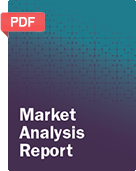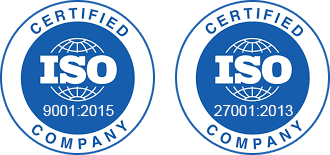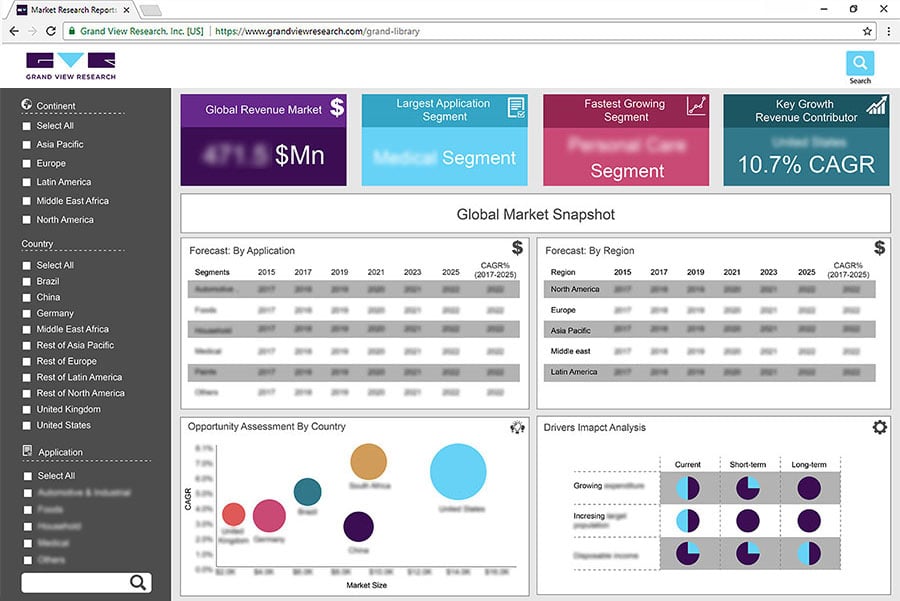
Clinical Laboratory Services Market Size, Share & Trends Analysis Report By Test Type (Human & Tumor Genetics, Clinical Chemistry), By Service Provider, By Application, By Region, And Segment Forecasts, 2024 - 2030
- Report ID: 978-1-68038-250-1
- Number of Report Pages: 150
- Format: PDF, Horizon Databook
- Historical Range: 2018 - 2022
- Forecast Period: 2024 - 2030
- Industry: Healthcare
Research Methodology
A three-pronged approach was followed for deducing the clinical laboratory service market estimates and forecasts. The process has three steps: information procurement, analysis, and validation. The whole process is cyclical, and steps repeat until the estimates are validated. The three steps are explained in detail below:
Information procurement: Information procurement is one of the most extensive and important stages in our research process, and quality data is critical for accurate analysis. We followed a multi-channel data collection process for clinical laboratory service market to gather the most reliable and current information possible.
- We buy access to paid databases such as Hoover’s and Factiva for company financials, industry information, white papers, industry journals, SME journals, and more.
- We tap into Grand View’s proprietary database of data points and insights from active and archived monitoring and reporting.
- We conduct primary research with industry experts through questionnaires and one-on-one phone interviews.
- We pull from reliable secondary sources such as white papers and government statistics, published by organizations like WHO, NGOs, World Bank, etc., Key Opinion Leaders (KoL) publications, company filings, investor documents, and more.
- We purchase and review investor analyst reports, broker reports, academic commentary, government quotes, and wealth management publications for insightful third-party perspectives.
Analysis: We mine the data collected to establish baselines for forecasting, identify trends and opportunities, gain insight into consumer demographics and drivers, and so much more. We utilized different methods of clinical laboratory service market data depending on the type of information we’re trying to uncover in our research.
-
Market Research Efforts: Bottom-up Approach for estimating and forecasting demand size and opportunity, top-down Approach for new product forecasting and penetration, and combined approach of both Bottom-up and Top-down for full coverage analysis.
-
Value-Chain-Based Sizing & Forecasting: Supply-side estimates for understanding potential revenue through competitive benchmarking, forecasting, and penetration modeling.
-
Demand-side estimates for identifying parent and ancillary markets, segment modeling, and heuristic forecasting.
-
Qualitative Functional Deployment (QFD) Modelling for market share assessment.
Market formulation and validation: We mine the data collected to establish baselines for forecasting, identify trends and opportunities, gain insight into consumer demographics and drivers, and so much more. We utilize different methods of data analysis depending on the type of information we’re trying to uncover in our research.
-
Market Formulation: This step involves the finalization of market numbers. This step on an internal level is designed to manage outputs from the Data Analysis step.
-
Data Normalization: The final market estimates and forecasts are then aligned and sent to industry experts, in-panel quality control managers for validation.
-
This step also entails the finalization of the report scope and data representation pattern.
-
Validation: The process entails multiple levels of validation. All these steps run in parallel, and the study is forwarded for publishing only if all three levels render validated results.
Clinical Laboratory Service Market Categorization:
The clinical laboratory service market was categorized into four segments, namely test type (Human & Tumor Genetics, Clinical Chemistry, Medical Microbiology & Cytology), service provider (Hospital-based Laboratories, Stand-alone Laboratories, Clinic-based Laboratories), application (Bioanalytical & Lab Chemistry Services, Toxicology Testing Services, Cell & Gene Therapy Related Services, Preclinical & Clinical Trial Related Services, Drug Discovery & Development Related Services) region (North America, Europe, Asia Pacific, Latin America, Middle East & Africa)
Segment Market Methodology:
The clinical laboratory service market was segmented into test type, service provider, application, and regions. The demand at a segment level was deduced using a funnel method. Concepts like the TAM, SAM, SOM, etc., were put into practice to understand the demand. We at GVR deploy three methods to deduce market estimates and determine forecasts. These methods are explained below:
Market research approaches: Bottom-up
-
Demand estimation of each product across countries/regions summed up to from the total market.
-
Variable analysis for demand forecast.
-
Demand estimation via analyzing paid database, and company financials either via annual reports or paid database.
-
Primary interviews for data revalidation and insight collection.
Market research approaches: Top-down
-
Used extensively for new product forecasting or analyzing penetration levels.
-
Tool used invoice product flow and penetration models Use of regression multi-variant analysis for forecasting Involves extensive use of paid and public databases.
-
Primary interviews and vendor-based primary research for variable impact analysis.
Market research approaches: Combined
- This is the most common method. We apply concepts from both the top-down and bottom-up approaches to arrive at a viable conclusion.
Regional Market Methodology:
The clinical laboratory service market was analyzed at a regional level. The globe was divided into North America, Europe, Asia Pacific, Latin America, and Middle East & Africa, keeping in focus variables like consumption patterns, export-import regulations, consumer expectations, etc. These regions were further divided into twenty namely, the U.S.; Canada; Germany; the UK.; France; Italy; Spain; China; Japan; India; Australia; South Korea; Brazil; Mexico; Colombia; Peru; Argentina; South Africa; Saudi Arabia; UAE,
All three above-mentioned market research methodologies were applied to arrive at regional-level conclusions. The regions were then summed up to form the global market.
Clinical laboratory Service market companies & financials:
The clinical laboratory service market was analyzed via companies operating in the sector. Analyzing these companies and cross-referencing them to the demand equation helped us validate our assumptions and conclusions. Key market players analyzed include:
-
Abbott - Abbott has a presence in more than 150 countries with research, manufacturing, sales, and distribution facilities. Its pharmaceuticals segment offers generic medicines for pain, fever, migraine, inflammation, pancreatic disorders, & hypertension; cardiovascular & metabolic products; and vaccines. The diagnostic segment offers reagents and tests for various applications. The company’s diagnostics portfolio includes technologies such as polymerase chain reaction, fluorescence in situ hybridization, and DNA & RNA sequencing.
-
QIAGEN - QIAGEN is a company that caters to the biotechnology industry. It provides samples and assay technologies for academic research, applied testing, molecular diagnostics, & pharmaceutical research. The company markets over 500 products, including consumable kits and automation systems. Its products for molecular diagnostics cover relevant areas of healthcare, ranging from early diagnosis of diseases, establishment of diagnosis, and diagnostic testing for determination of suitable treatment to point-of-need testing. The company’s customers include healthcare providers, pharmaceutical & biotechnology companies, governments or industrial customers, and researchers.
-
Quest Diagnostics - Quest Diagnostics is a provider of clinical laboratory tests. The company was established as Metropolitan Pathology Laboratory, Inc., and in 1997 it became an independent corporation called Quest Diagnostics. The company has administrative offices in Lyndhurst, Collegeville, and Pennsylvania. In 2013, Fortune magazine ranked the company at apex position in pharmacy and other services. The company employs over 47,000 employees globally.
-
OPKO Health, Inc. - It is a healthcare company that established itself in large and growing markets. The company’s diagnostics business refers to BioReference Laboratories, a clinical lab with genetic testing ability that includes the 4Kscore, a prostate cancer screening test, and the Claros1 immunoassay testing platform. The company focuses on novel molecular diagnostics, point-of-care, vaccines, and proprietary pharmaceuticals. In August 2015, OPKO Health, Inc. acquired BioReference Laboratories.
-
Siemens Medical Solutions USA, Inc. - It is a provider of healthcare solutions such as diagnostics (in vitro & in vivo), imaging & therapy systems, clinical products, audiology solutions, and healthcare IT solutions. The company was founded as a separate entity in 2015. It also offers medical accessories, OEM component & medical electronics solutions, refurbished systems for medical imaging & therapy, and technical, maintenance, & professional & consulting services. Its products and solutions are used in various areas like therapeutic drug monitoring cardiology, organ transplant, urology, infectious diseases, diabetes, women's health, surgery, oncology, neurology, and growth disorders.
-
NeoGenomics Laboratories - In 2015, NeoGenomics acquired Clarient for USD 275 million. Clarient, Inc., formerly known as ChromaVision Medical Systems, was incorporated in 1993 and located in California, U.S. The company changed its name to Clarient, Inc. in 2005. The company is engaged in providing diagnostics and cancer testing services. It is focused on breast cancer recurrence testing, breast cancer testing, KRAS in colorectal cancer, colon cancer testing, pulmotype test, and mutation testing. The range of tests provided by the company includes FISH, BRAF, ALK Rearrangement, EGFR mutation analysis, Mammostrat, and PI3K.
-
Fresenius Medical Care - Fresenius Medical Care is a provider of products to treat chronic kidney failure. The company has worldwide operations supported by 37 production sites and offers dialysis products like dialysis machines & other related disposables. The company has its North American headquarters in Waltham, Massachusetts, and Asia Pacific headquarters in Hong Kong. In 1997, Fresenius Medical Care Holdings, Inc. acquired Spectra Laboratories for its kidney dialysis laboratory in the U.S.
-
ARUP Laboratories - Associated Regional and University Pathologists, Inc. is a nonprofit enterprise laboratory of the Department of Pathology, University of Utah. The company serves as the national reference for the U.S. ARUP provides a variety of about 3,000 tests and their combinations encompassing various fields of clinical medicine, such as clinical chemistry, cytogenetics, immunology, molecular genetics, endocrinology, obstetrics, neonatology, neurology, pediatrics, oncology, hematology, anatomic pathology, and infectious diseases. The company works on a 24×7 model and processes between 30,000 & 35,000 blood and fluid samples a day.
-
Sonic Healthcare - Sonic Healthcare provides radiology & laboratory pathology services and follows a federation model with largely decentralized operations. The company is divided into a decentralized federation of medically led practices. It is the third-largest pathology/laboratory medicine company with operations in eight countries. The company employs around 800 specialist pathologists, over 200 radiologists, and others as general practitioners & medical scientists with technicians. In 2007, the company acquired Bioscientia Institut für Medizinische Diagnostik GmbH.
-
Charles River Laboratories - Charles River Laboratories International offers a wide range of clinical and preclinical laboratory services to biotechnology industries, government agencies, and pharmaceutical & medical devices companies. It was incorporated in 1947 and is headquartered in Massachusetts, U.S. The company’s key business areas are basic research, clinical support, and process manufacturing. Its business is segmented into research models & services, discovery & safety assessment, and manufacturing support. Over 60% of revenue is generated from the discovery & safety assessment segment. The company has 65 facilities across 16 countries. It employs over 17,000 people globally.
Value chain-based sizing & forecasting
Supply Side Estimates
-
Company revenue estimation via referring to annual reports, investor presentations, and Hoover’s.
-
Segment revenue determination via variable analysis and penetration modeling.
-
Competitive benchmarking to identify market leaders and their collective revenue shares.
-
Forecasting via analyzing commercialization rates, pipelines, market initiatives, distribution networks, etc.
Demand side estimates
-
Identifying parent markets and ancillary markets
-
Segment penetration analysis to obtain pertinent
-
revenue/volume
-
Heuristic forecasting with the help of subject matter experts
-
Forecasting via variable analysis
Clinical Laboratory Service Market Report Objectives:
-
Understanding market dynamics (in terms of drivers, restraints, & opportunities) in the countries.
-
Understanding trends & variables in the individual countries & their impact on growth and using analytical tools to provide high-level insights into the market dynamics and the associated growth pattern.
-
Understanding market estimates and forecasts (with the base year as 2022, historic information from 2018 to 2021, and forecast from 2023 to 2030). Regional estimates & forecasts for each category are available and are summed up to form the global market estimates.
Clinical Laboratory Service Market Report Assumptions:
-
The report provides market value for the base year 2022 and a yearly forecast till 2030 in terms of revenue/volume or both. The market for each of the segment outlooks has been provided on region & country basis for the above-mentioned forecast period.
-
The key industry dynamics, major technological trends, and application markets are evaluated to understand their impact on the demand for the forecast period. The growth rates were estimated using correlation, regression, and time-series analysis.
-
We have used the bottom-up approach for market sizing, analyzing key regional markets, dynamics, & trends for various products and end-users. The total market has been estimated by integrating the country markets.
-
All market estimates and forecasts have been validated through primary interviews with the key industry participants.
-
Inflation has not been accounted for to estimate and forecast the market.
-
Numbers may not add up due to rounding off.
-
Europe consists of EU-8, Central & Eastern Europe, along with the Commonwealth of Independent States (CIS).
-
Asia Pacific includes South Asia, East Asia, Southeast Asia, and Oceania (Australia & New Zealand).
-
Latin America includes Central American countries and the South American continent
-
Middle East includes Western Asia (as assigned by the UN Statistics Division) and the African continent.
Primary Research
GVR strives to procure the latest and unique information for reports directly from industry experts, which gives it a competitive edge. Quality is of utmost importance to us, therefore every year we focus on increasing our experts’ panel. Primary interviews are one of the critical steps in identifying recent market trends and scenarios. This process enables us to justify and validate our market estimates and forecasts to our clients. With more than 8,000 reports in our database, we have connected with some key opinion leaders across various domains, including healthcare, technology, consumer goods, and the chemical sector. Our process starts with identifying the right platform for a particular type of report, i.e., emails, LinkedIn, seminars, or telephonic conversation, as every report is unique and requires a differentiated approach.
We send out questionnaires to different experts from various regions/ countries, which is dependent on the following factors:
-
Report/Market scope: If the market study is global, we send questionnaires to industry experts across various regions, including North America, Europe, Asia Pacific, Latin America, and MEA.
-
Market Penetration: If the market is driven by technological advancements, population density, disease prevalence, or other factors, we identify experts and send out questionnaires based on region or country dominance.
The time to start receiving responses from industry experts varies based on how niche or well-penetrated the market is. Our reports include a detailed chapter on the KoL opinion section, which helps our clients understand the perspective of experts already in the market space.



